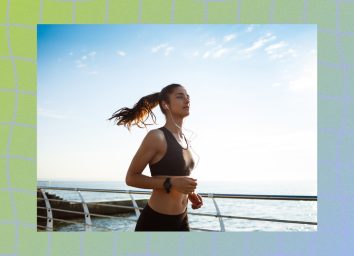5 Standing Stretches People Swear By To Melt Belly Fat Fast
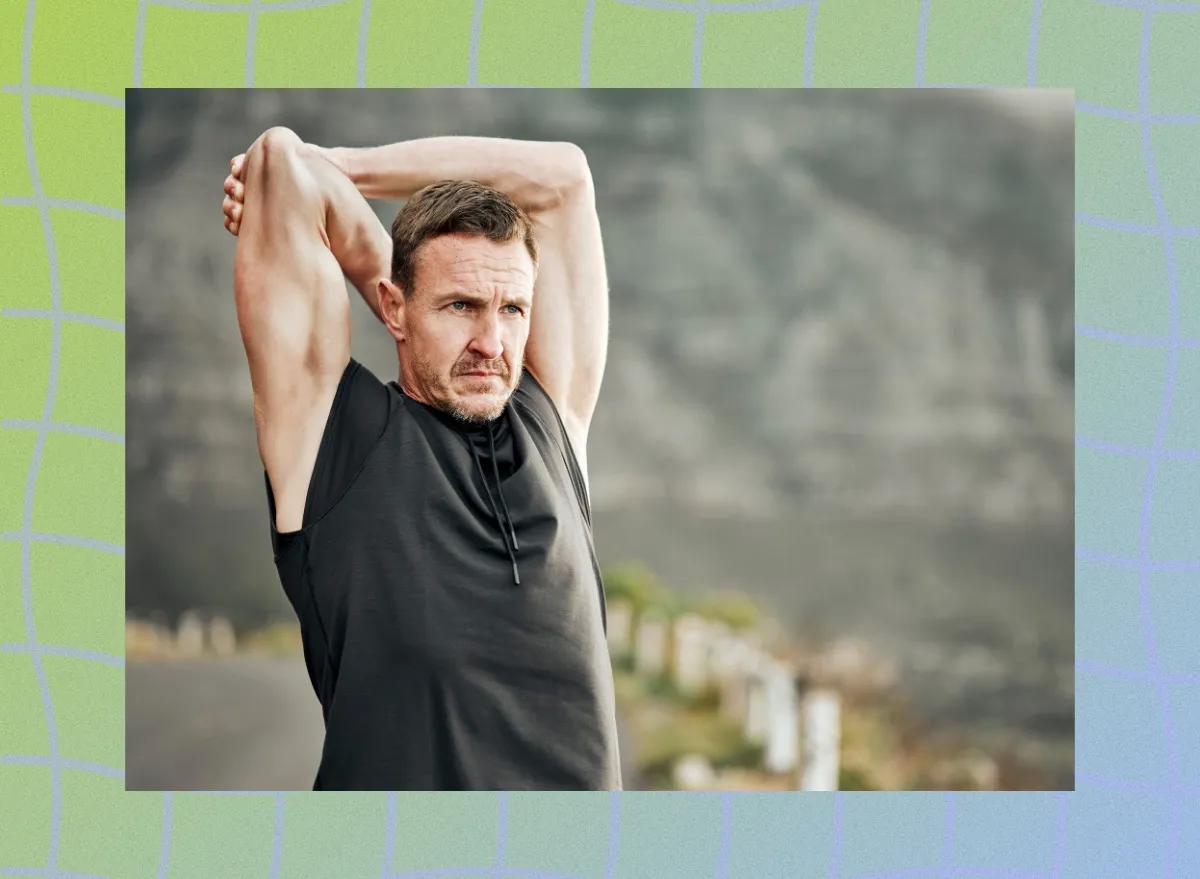
As a fitness professional with over 25 years of experience, I've seen firsthand how morning movement transforms both body and mind. Most of us struggle with finding time for fitness in our busy lives, especially first thing in the morning. But what if just a few minutes of targeted stretching could energize your day, tone the body, and help with weight management? These simple standing stretches can become your new favorite morning ritual.
The Science Behind Morning Stretches
Morning stretches benefit us in ways that extend far beyond simple flexibility. When we move our joints through their full range of motion while practicing calm breathing patterns, we're not only preparing muscles and joints for the day ahead but also activating the parasympathetic nervous system, which reduces stress.
The question has less to do with stretches but with how stretching, joint end-range stimulation, and muscle spindle activation stimulate the parasympathetic nervous system and does this, in turn, regulate thermogenesis, which is related to cellular metabolism and organ function and blood glucose levels.
The general consensus is that stretching induces the relaxation response, this response down-regulates the sympathetic nervous system, that fights or flight response we have in the presence of stress and enhances parasympathetic tone, which then sets all physiological responses to be more efficient, including cellular metabolism, insulin control, and uptake. Muscles are also important here as stretches prepare muscles, whose fibers are rich with mitochondria, the energy producers, to work more effectively and efficiently against load, building strength, which in turn enhances metabolism.
This simple, 20-minute Pilates-inspired stretching workout is designed to increase flexibility and circulation throughout the entire body and can be done at any time throughout your day.
Perfect Your Standing Posture
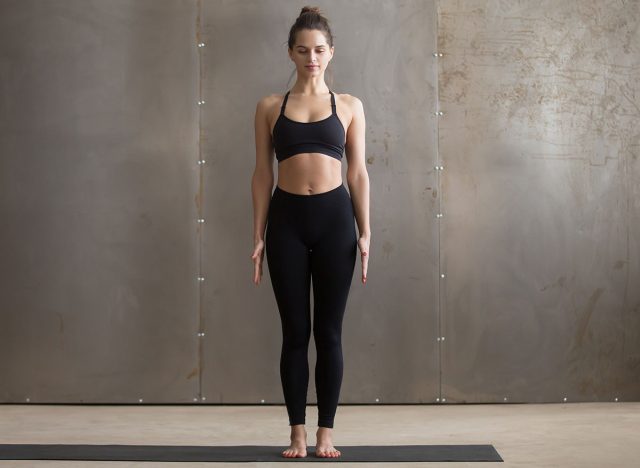
Get up! If sitting is so deleterious, standing up is the first and most important thing we can do. Stand tall, and check your posture. Feel the balance of your head floating over your ribcage, your ribcage over your pelvis, and your pelvis directly over your legs. Notice, is your head in line with your shoulder? Is your spine lifted up out of your pelvis? Exhale and see if you can ground your feet into the floor while gently activating your abdominals to support your spine. This is the standing starting position for all of the exercises to follow.
While standing and finding your posture is great, remember that standing without moving is not enough. Stand up, find your tall posture then walk around, get water, go to the bathroom, take a lap around the building you work in. If there are stairs, walking up and down the stairs is even better! Try getting up for at least 5 minutes every hour.
Heel Raises for Better Circulation
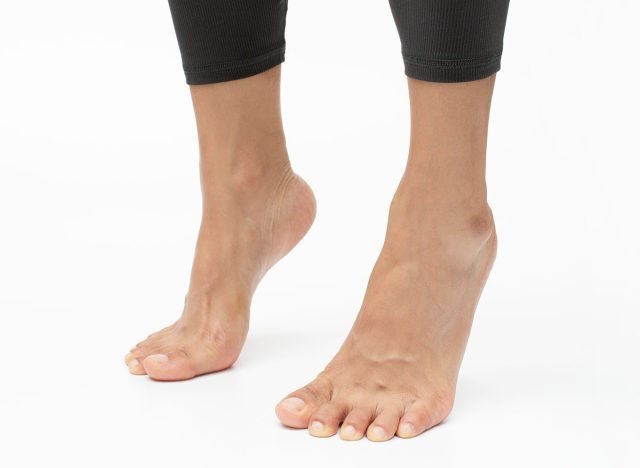
In fitness, the feet and ankles do not get much attention, but in Pilates, the importance of strong, mobile, and flexible feet and ankles are seen as directly related to balance and whole-body coordination. In addition, the pumping action of the calf muscles is very important to create circulation in the lower leg.
From your tall standing posture, rise up onto the balls of your feet. As you lower your heels back to the ground, keep lengthening and reaching the crown of your head to the ceiling. In other words, as you lower your heels to the ground, imagine you are actually getting taller. This will affect not only your ankles and feet but also the postural muscles along your spine. 5 to 8 of these will leave you feeling grounded in your legs and overall taller and more upright.
Standing Roll Down for Spine Flexibility
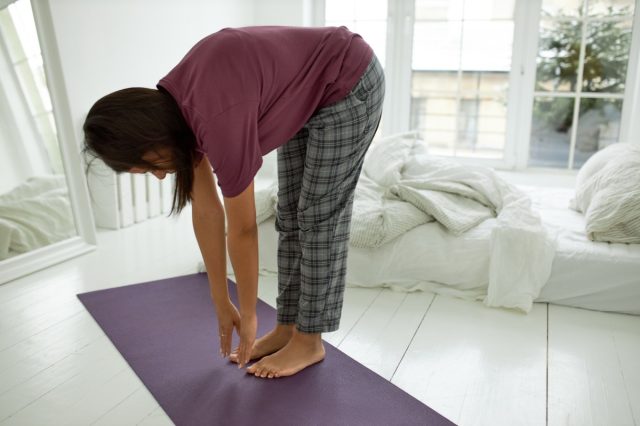
Joseph Pilates infamously said, "If your spine is inflexibly stiff at 30, you are old. If it is completely flexible at 60, you are young." I think we can all agree he got that right! Sitting all day in front of a computer leaves the spine often unsupported and slumped forward. As a result, spinal muscles are not doing their job of supporting our spine; our glutes are literally functioning as a cushion, and our hips are compressed in flexion. No wonder it's hard to stand up!
While standing, take a moment to take stock of your posture.
Your roll down starts from your head. Nod your head, then imagine rolling through your spine, one vertebra at a time. Roll down as far as comfortable and stop if you experience any back pain or discomfort. As you roll down, imagine drawing your abdominals in and up to support the front of your spine. Note: If the floor simply seems too far away, stand close to a desk or countertop and roll down until your hands find the support of the desk. Once the desk is achievable, then try for something lower, such as the seat of the chair, and then finally to the floor.
To reverse, plant your feet firmly into the ground and start to roll up your spine. As you return to standing, imagine stacking one vertebra on top of the one below it. 3 to 5 of these are plenty.
Dynamic Leg Stretches
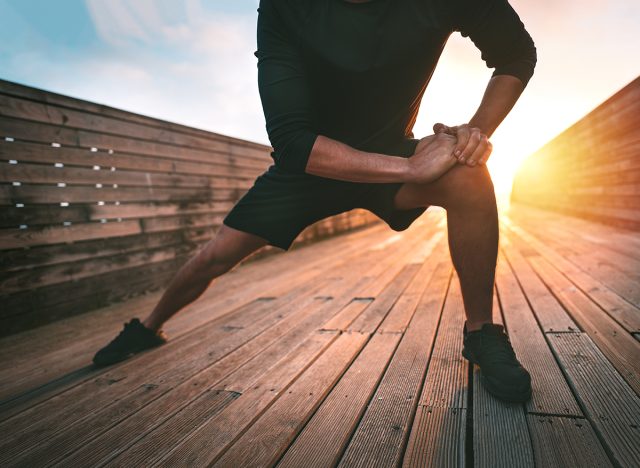
Keep these stretches dynamic by keeping the movement continuous. Kiss the stretch, then move out of the stretch. Repeat as desired.
Hamstrings (back of the thigh)
From the roll-down position, bend your knees and bring your thighs toward your chest and your chest as close to your thighs as possible. From this position, straighten your legs, all the while trying to keep the chest as close to the thighs as possible.
Adductors (inner thigh)
Open legs wider than hip-width apart and place hands on the countertop, tabletop, or desktop. Shift weight to one leg by bending the knee. Keep the other leg straight, and this is the leg that should feel the stretch. Repeat on the other side.
Abductor (outside of the thigh)
It can be done standing sideways on a table or desk. For deeper stretch under a door-way is optimal. Stand side facing a table or doorframe. Cross right leg in front of left leg at the ankles. Place the left hand on a table or hold onto the door jam. Side bend to the left. As you do so, the right arm can reach up and overhead. If inside of a door jam, hold the jam as you focus on stretching into the right hip.
Standing Reach and Extension
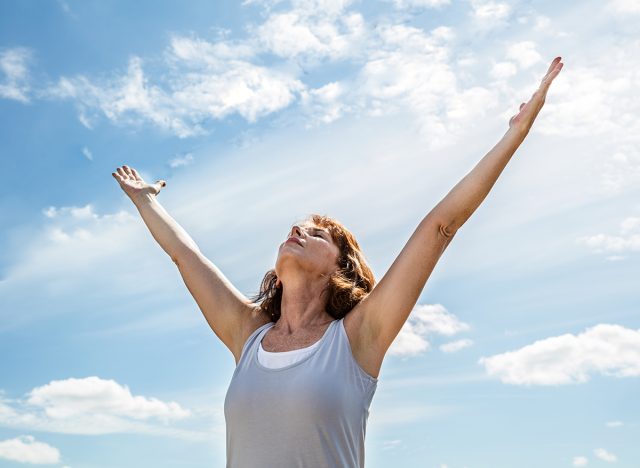
Standing upright, open the arms out to the side, raise the arms overhead, and reach for the ceiling while extending the spine. Release by lowering the arms, bending the knees and flexing the spine. Repeat this yummy move as often as you like.
Bonus Moves: Squats, Lunges and Push-Ups
While these are not Pilates-specific exercises, they are a necessity when combating the deleterious effects of sitting on the lower body. I literally do 10 of each of these moves every time I come back to my desk after going to the restroom. They are fitness staples that are excellent for building leg strength and, less widely known, are also excellent exercises for strengthening the pelvic floor (a story for another time but a victim of our seated life nonetheless!).
Squats
Narrow – stand with legs hip width or slightly wider, the feet are parallel. Lower into a squat by bending at the hips, knees, and ankles. The spine remains straight as the torso tilts over the thighs. At the bottom of the squat you should feel work in your quadriceps and your hamstrings for sure, and your weight should be balanced over your legs.
Wide – Open the legs wider than the hips and slightly turn out the legs. With a wider stance, you can lower further down.
Try 10 repetitions, then on the final repetition, hold the position and count to 10 slowly. You can also pulse in the squat position. These small pulses will generate a lot of heat quickly. Try lifting your heels as you pulse, and wow, quads on fire!
Lunges
Ten repetitions of each lunge in succession will definitely create strength and muscular balance quickly.
Back leg focus
Stagger your legs in a split stance, one forward and one behind. Keep your torso upright and your spine is straight through the movement. Bend both knees and lower into a lunge. The back knee should be directly under the pelvis, creating a straight line from the head to the torso to the knee. Note: for a little support, place one hand on top of your desk as you lower into the lunge. Just that small amount of contact will allow you to lower deeper into the lunge while providing control and balance.
Front leg focus
Stand tall with weight even on both legs. Take a step forward with one leg and bend that knee to lower into a lunge. The back leg remains straight and the body tilts forward over the lunging leg.
Sidestepping lunge – From standing, step out to the side with the right leg while stepping behind with the left leg. Bend both knees and lower into a side-stepping lunge. Stand up to return to the starting position and reverse sides.
Countertop Push-Ups
This exercise is one I will do after I wash and dry my hands right at the restroom countertop (I confess, we have a very clean and quiet bathroom. If your bathroom is questionable, then by all means, the desktop is your better bet!). This exercise is more than an arm exercise as it helps to strengthen the muscles along your spine, which counteracts the forward slump of the spine while sitting. 10 repetitions for each trip to the bathroom should do the trick!
Place your hands on top of the counter, or your desk, and step back until the body is in one long diagonal line. Bend and straighten the arms. As the arms bend the body lowers toward the desk, as the arms straighten the body returns to starting position.
Although your arms are certainly working hard, your spinal muscles and your core are working to support the spine, and your legs should be active to support your lower body.
Making Morning Stretches Part of Your Routine
Wake up, move around a bit, walk or simply shake out your body, then move into the stretches.
For the best results, stretch first, drink water, then if you are preparing to work out, drink water and then eat breakfast.
My top advice for beginners? Take it easy and do not judge. Do what you can, ease into the stretch—I like to say kiss it, and release. Do not forget to breathe and allow the breath to motivate the stretch, not the other way around. And if you enjoyed this article, don't miss How Long Your Walking Workout Should Be To Shrink Belly Fat.




